A New Framework for Understanding Urban Social Vulnerability from a Network Perspective
Abstract
:1. Introduction
2. Literature Review: Conceptual Basis and Evolution of Vulnerability
3. Materials and Methods
3.1. A New Conceptual Framework from a Network Perspective
3.2. Study Area
3.3. Data
3.4. Method
- (1)
- With attribute data, the traditional urban SVI was regarded as an index of individual nodes (each city) without connectivity and was evaluated with the projection pursuit cluster (PPC) model. The detailed procedure is as follows:Step 1: Normalize the values of proxy indicators by using the min-max rescaling transformation method.Step 2: Develop the index function Q(a). First, the dataset of {x(i, j)|i = 1, 2,…, n; j = 1, 2,…, p} (n = 16, p = 13) was converted into a one-dimensional projection value z(i):where a(j) is a p-dimensional unit vector of the projection direction. Different projection directions revealed different features of the data structure. An optimal projection direction, or the direction exposing the most interesting structure of high dimension data, was taken as the weight of the indicator in this paper. To find the optimal projection, the index function Q(a) was evaluated as follows:where E(z) is the mean of z(i); R is the local density radius of the window set as ; corresponds to the distance between the sample and was set as ; and u(t) is the unit step function: .Step 3: Based on the program of the real-coded genetic algorithm implemented in PYTHON, Q(a) was maximized to find the optimal projection a*(j). a*(j) also corresponded to the best suitable weights of social vulnerability indicators. Next, the traditional urban SVI (labelled as the SVInode) was calculated:where a*(j) is the optimal projection direction.More detailed steps were illustrated in our previous paper: Mapping Social Vulnerability to Air Pollution: A Case Study of the Yangtze River Delta Region, China [19].
- (2)
- With the relational data retrieved from the Baidu Index, the new dimension (connectivity) of social vulnerability (labelled as SVIconnectivity) was calculated according Equation (2).where i and j represent the city (n = 16 for this case). The first item corresponded to the total searches from all the other 15 cities to city i, which meant the sum of information flowing in city i. For example, if city i = Shanghai, this item records all of the search data where the search topic is “Shanghai” and the search regions are “Yangzhou, Taizhou, Nantong, Nanjing, Zhenjiang, Changzhou, Wuxi, Suzhou, Huzhou, Jiaxing, Hangzhou, Shaoxing, Ningbo, Zhoushan and Taizhou”. The second item represents the total searches from city i to all the other 15 cites, which means the sum of information flowing out of city i. In the above example, if city i = Shanghai, then the search topic is any one of “Yangzhou, Taizhou, Nantong, Nanjing, Zhenjiang, Changzhou, Wuxi, Suzhou, Huzhou, Jiaxing, Hangzhou, Shaoxing, Ningbo, Zhoushan and Taizhou”, while, the search region is “Shanghai”. The third item represents the searches from city i to itself, that is, the search topic and search region are both “Shanghai”.
- (3)
- As above-mentioned, a node with better connectivity should be less vulnerable to disasters. Hence, the urban SVI was modelled as follows:
4. Results and Discussion
4.1. Connectivity
4.2. SVInode and SVIurban
5. Discussion and Conclusions
Acknowledgments
Author Contributions
Conflicts of Interest
References
- Andrey, J.; Jones, B. The dynamic nature of social disadvantage: Implications for hazard exposure and vulnerability in Greater Vancouver. Can. Geogr. 2008, 1, 146–168. [Google Scholar] [CrossRef]
- Voskamp, I.M.; Van de Ven, F.H.M. Planning support system for climate adaptation: Composing effective sets of blue-green measures to reduce urban vulnerability to extreme weather events. Build. Environ. 2015, 83, 159–167. [Google Scholar] [CrossRef]
- Zhao, Y.; Wang, S.; Zhou, C. Science of the Total Environment Understanding the relation between urbanization and the eco-environment in China’s Yangtze River Delta using an improved EKC model and coupling analysis. Sci. Total Environ. 2016, 571, 862–875. [Google Scholar] [CrossRef] [PubMed]
- Gong, P.; Liang, S.; Carlton, E.J.; Jiang, Q.; Wu, J.; Wang, L. Urbanisation and health in China. NIH Public Access 2012, 379, 843–852. [Google Scholar] [CrossRef]
- Kasperson, J.; Kasperson, R.; Turner, B.; Schiller, A.; Hsieh, W. Vulnerability to global environmental change. In The Human Dimensions of Global Environmental Change; Diek-mann, A., Dietz, T., Jaeger, C., Rosa, E., Eds.; MIT Press: Cambridge, MA, USA, 2003. [Google Scholar]
- Su, S.; Pi, J.; Wan, C.; Li, H.; Xiao, R.; Li, B. Categorizing social vulnerability patterns in Chinese coastal cities. Ocean Coast. Manag. 2015, 116, 1–8. [Google Scholar] [CrossRef]
- Brooks, N.; Neil Adger, W.; Mick Kelly, P. The determinants of vulnerability and adaptive capacity at the national level and the implications for adaptation. Glob. Environ. Chang. 2005, 15, 151–163. [Google Scholar] [CrossRef]
- Adger, W.N. Vulnerability. Glob. Environ. Chang. 2006, 16, 268–281. [Google Scholar] [CrossRef]
- Cutter, S.L.; Finch, C. Temporal and spatial changes in social vulnerability to natural hazards. Proc. Natl. Acad. Sci. USA 2008, 7, 2301–2306. [Google Scholar] [CrossRef] [PubMed]
- King, R.A.R.; Blackmore, K.L. Physical and political boundaries as barriers to the continuity of social vulnerability. Appl. Geogr. 2013, 44, 79–87. [Google Scholar] [CrossRef]
- Lee, Y.-J. Social vulnerability indicators as a sustainable planning tool. Environ. Impact Assess. Rev. 2014, 44, 31–42. [Google Scholar] [CrossRef]
- Birkmann, J. Measuring vulnerability to promote disaster-resilient societies: Conceptual frameworks and definitions. In Measuring Vulnerability; United Nations University Press: New Delhi, India, 2006; pp. 9–54. [Google Scholar]
- Ciurean, R.L.; Schröter, D.; Glade, T. Conceptual Frameworks of Vulnerability Assessments for Natural Disasters Reduction. In Approaches to Disaster Management—Examining the Implications of Hazards, Emergencies and Disasters; InTech Open Access Publisher: Rijeka, Croatia, 2013. [Google Scholar]
- Füssel, H.-M. Vulnerability: A generally applicable conceptual framework for climate change research. Glob. Environ. Chang. 2007, 17, 155–167. [Google Scholar] [CrossRef]
- Li, X.; Zhou, Y.; Tian, B.; Kuang, R.; Wang, L. GIS-based methodology for erosion risk assessment of the muddy coast in the Yangtze Delta. Ocean Coast. Manag. 2015, 108, 97–108. [Google Scholar] [CrossRef]
- Janssen, M.A.; Schoon, M.L.; Ke, W.; Bo, K. Scholarly networks on resilience, vulnerability and adaptation within the human dimensions of global environmental change. Glob. Environ. Chang. 2006, 16, 240–252. [Google Scholar] [CrossRef]
- Vogel, C.; Moser, S.C.; Kasperson, R.E.; Dabelko, G.D. Linking vulnerability, adaptation, and resilience science to practice: Pathways, players, and partnerships. Glob. Environ. Chang. 2007, 17, 349–364. [Google Scholar] [CrossRef]
- Neil, L.; Conde, C.; Kulkarni, J.; Nyong, A.; Pulbin, J. Climate Change and Vulnerability; Earthscan: London, UK; Sterling, VA, USA, 2008. [Google Scholar]
- Ge, Y.; Zhang, H.; Dou, W.; Chen, W.; Liu, N.; Wang, Y.; Shi, Y.; Rao, W. Mapping Social Vulnerability to Air Pollution: A Case Study of the Yangtze River Delta Region, China. Sustainability 2017, 9, 109. [Google Scholar] [CrossRef]
- Ge, Y.; Dou, W.; Liu, N. Planning Resilient and Sustainable Cities: Identifying and Targeting Social Vulnerability to Climate Change. Sustainability 2017, 9. [Google Scholar] [CrossRef]
- Zhou, Y.; Li, N.; Wu, W.; Wu, J.; Shi, P. Local spatial and temporal factors influencing population and societal vulnerability to natural disasters. Risk Anal. 2014, 34, 614–639. [Google Scholar] [CrossRef] [PubMed]
- Cutter, S.L.; Boruff, B.J.; Shirley, W.L. Social Vulnerability to Environmental Hazards. Soc. Sci. Q. 2003, 84, 242–261. [Google Scholar] [CrossRef]
- Yenneti, K.; Tripathi, S.; Wei, Y.D.; Chen, W.; Joshi, G. The truly disadvantaged? Assessing social vulnerability to climate change in urban India. Habitat Int. 2016, 56, 124–135. [Google Scholar] [CrossRef]
- Wisner, B.; Blaikie, P.; Cannon, T.; Davis, I. At Risk: Natural Hazards, People’s Vulnerability, and Disasters, 2nd ed.; Routledge: London, UK, 2004. [Google Scholar]
- Singh, S.R.; Eghdami, M.R.; Singh, S. The Concept of Social Vulnerability: A Review from Disasters Perspectives. Int. J. Interdiscip. Multidiscip. Stud. 2014, 1, 71–82. [Google Scholar]
- Lee, Y.; Lin, S.; Chen, C. Mapping Cross-Boundary Climate Change Vulnerability—Case Study of the Hualien and Taitung Area, Taiwan. Sustainability 2016, 8, 64. [Google Scholar] [CrossRef]
- Few, R. Health and climatic hazards: Framing social research on vulnerability, response and adaptation. Glob. Environ. Chang. 2007, 17, 281–295. [Google Scholar] [CrossRef]
- Füssel, H.M.; Klein, R.J.T. Climate change vulnerability assessments: An evolution of conceptual thinking. Clim. Chang. 2006, 75, 301–329. [Google Scholar] [CrossRef]
- IPCC. Climate Change 2001: Impacts, Adaptation and Vulnerability; McCarthy, J.J., Canziani, O.F., Leary, N.A., Dokken, D.J., White, K.S., Eds.; Cambridge University Press: Cambridge, UK, 2001. [Google Scholar]
- Fellmann, T. The assessment of climate change-related vulnerability in the agricultural sector: Reviewing conceptual frameworks. Build. Resil. Adapt. Clim. Chang. Agric. Sect. 2012. [Google Scholar] [CrossRef]
- IPCC. Climate Change 2007: The Physical Science Basis; Solomon, S., Qin, D., Manning, M., Chen, Z., Marquis, M., Averyt, K.B., Tignor, M., Miller, H.L., Eds.; Cambridge University Press: Cambridge, UK, 2007. [Google Scholar]
- Brooks, N. Vulnerability, Risk and Adaptation: A Conceptual Framework; Tyndall Centre Working Paper No. 38; Tyndall Centre for Climate Change Research: Norwich, UK, 2003. [Google Scholar]
- Firman, T.; Surbakti, I.M.; Idroes, I.C.; Simarmata, H.A. Potential climate-change related vulnerabilities in Jakarta: Challenges and current status. Habitat Int. 2011, 35, 372–378. [Google Scholar] [CrossRef]
- Nahiduzzaman, K.M.; Aldosary, A.S.; Rahman, M.T. Flood induced vulnerability in strategic plan making process of Riyadh city. Habitat Int. 2015, 49, 375–385. [Google Scholar] [CrossRef]
- Blaikie, P.; Cannon, T.; Davis, I.; Wisner, B. At Risk: Natural Hazards, People’s Vulnerability, and Disasters; Routledge: London, UK, 1994. [Google Scholar]
- Cutter, S.L. Vulnerability to environmental hazards. Prog. Hum. Geogr. 1996, 20, 529–539. [Google Scholar] [CrossRef]
- Turner, B.L., II; Kasperson, R.E.; Matson, P.A.; Mccarthy, J.J.; Corell, R.W.; Christensen, L.; Eckley, N.; Kasperson, J.X.; Luers, A.; Martello, M.L.; et al. A framework for vulnerability analysis in sustainability science. Proc. Natl. Acad. Sci. USA 2003, 100, 8074–8079. [Google Scholar] [CrossRef] [PubMed]
- Jahre, M.; Fabbe-Costes, N. Adaptation and adaptability in logistics networks. Int. J. Logist. Res. Appl. 2005, 8, 143–157. [Google Scholar] [CrossRef]
- O’Brien, K.L.; Leichenko, R.; Kelkarc, U.; Venemad, H.; Aandahl, G.; Tompkins, H.; Javed, A.; Bhadwal, S.; Barg, S.; Nygaard, L.; et al. Mapping vulnerability to multiple stressors: Climate change and globalization in India. Glob. Environ. Chang. 2004, 14, 303–313. [Google Scholar] [CrossRef]
- Chen, W.; Cutter, S.L.; Emrich, C.T.; Shi, P. Measuring social vulnerability to natural hazards in the Yangtze River Delta region, China. Int. J. Disaster Risk Sci. 2013, 4, 169–181. [Google Scholar] [CrossRef]
- Birkmann, J.; Cardona, O.D.; Carreño, M.L.; Barbat, A.H.; Pelling, M.; Schneiderbauer, S.; Kienberger, S.; Keiler, M.; Alexander, D.; Zeil, P.; Welle, T. Framing vulnerability, risk and societal responses: The MOVE framework. Nat. Hazards 2013, 67, 193–211. [Google Scholar] [CrossRef]
- Maria, B.; Hummell, D.L.; Cutter, S.L.; Emrich, C.T. Social Vulnerability to Natural Hazards in Brazil. Int. J. Disaster Risk Sci. 2016, 7, 111–122. [Google Scholar]
- Cutter, S.L.; Emrich, C.T.; Webb, J.J.; Morath, D. Social Vulnerability to Climate the Literature Social Vulnerability to Climate Literature; Final Report to Oxfam America; University of South Carolina: Columbia, SC, USA, 2009; pp. 1–44. [Google Scholar]
- Stafford, S.; Abramowitz, J. An analysis of methods for identifying social vulnerability to climate change and sea level rise: A case study of Hampton Roads, Virginia. Nat. Hazards 2017, 85, 1089–1117. [Google Scholar] [CrossRef]
- Choi, J.H.; Barnett, G.A.; Chon, B.S. Comparing world city networks: A network analysis of Internet backbone and air transport intercity linkages. Glob. Netw. 2006, 6, 81–99. [Google Scholar] [CrossRef]
- Keiner, M.; Kim, A. Transnational City Networks for Sustainability Transnational City Networks for Sustainability. Eur. Plan. Stud. 2006, 15, 1369–1395. [Google Scholar] [CrossRef]
- Auria, A.J.D. City networks and sustainability—The role of knowledge and of cultural heritage in globalization. Int. J. Sustain. High. Educ. 2001, 2, 38–47. [Google Scholar] [CrossRef]
- Feng, Z.; Xia, W.; Jun, Y.I.N.; Min, Z. An Empirical Study on Chinese City Network Pattern Based on Producer Services. Chin. Geogr. Sci. 2013, 23, 274–285. [Google Scholar]
- Boulton, A.; Devriendt, L.; Brunn, S.; Derudder, B.; Witlox, F. City networks in cyberspace and time: Using Google hyperlinks to measure global economic and environmental crises. In ICTs for Mobile and Ubiquitous Urban Infrastructures: Surveillance, Locative Media and Global Networks; Firmino, R.J., Duarte, F., Ultramari, C., Eds.; IGI Global: Hershey, PA, USA, 2011; pp. 67–87. [Google Scholar]
- Castells, M. Urban Geography Grassrooting the Space of Flows Grassrooting the Space of Flows. Urban Geogr. 2017, 20, 294–302. [Google Scholar] [CrossRef]
- Zhao, J.; Song, Y.; Shi, L.; Tang, L. Study on the compactness assessment model of urban spatial form. Shengtai Xuebao Acta Ecol. Sin. 2011, 31, 6338–6343. [Google Scholar]
- Zakour, M.J.; Gillespie, D.F. Community Disaster Vulnerability: Theory, Research, and Practice; Springer Science & Business Media: New York, NY, USA, 2013. [Google Scholar]
- McEntire, D.A. Coordinating multi-organizational responses to disaster: Lessons from the 28 March 2000, Fort Worth Tornado. Disaster Prev. Manag. 2002, 11, 369–379. [Google Scholar] [CrossRef]
- Andrew, S.; Arlikatti, S.; Siebeneck, L.; Pongponrat, K.; Jaikampan, K. Sources of organisational resiliency during the Thailand floods of 2011: A test of the bonding and bridging hypotheses. Disasters 2016, 40, 65–84. [Google Scholar] [CrossRef] [PubMed]
- Xiong, L.; Zhen, F.; Wang, B.; Xi, G. The Research of the Yangtze River Delta Core Area’s City Network Characteristics Based on Baidu Index. Econ. Geogr. 2013, 33, 67–73. [Google Scholar]
- Xu, X.; Tan, Y.; Chen, S.; Yang, G.; Su, W. Urban Household Carbon Emission and Contributing Factors in the Yangtze River. PLoS ONE 2015, 10, e0121604. [Google Scholar] [CrossRef] [PubMed]
- Gu, C.; Hu, L.; Zhang, X.; Wang, X.; Guo, J. Climate change and urbanization in the Yangtze River Delta q. Habitat Int. 2011, 35, 544–552. [Google Scholar] [CrossRef]
- Colldahl, C.; Kelemen, J.E. Smart Cities: Strategic Sustainable Development for an Urban World. Master’s Thesis, School of Engineering, Blekinge Institute of Technology, Karlskrona, Sweden, 2013. [Google Scholar]
- Baidu Index. Available online: https://zhishu.baidu.com/ (accessed on 21 September 2017).
- Yu, X.; Wu, X. The Research of the Northeast Region City Network Characteristics Based on Baidu Index. Nat. Sci. J. Harbin Norm. Univ. 2015, 31, 114–118. [Google Scholar]
- Jiang, D.; Sun, Y.; Yang, T.; Ren, H.; Chen, Y.; Fu, Y.; Zhang, Z. Regional Disparity in the Network Attention of China to Southeast Asia Based on Baidu Index. Trop. Geogr. 2105, 35, 708–718. [Google Scholar]
- Chen, Z.; Zhao, Y.; Chen, Q. The Network Connectivity of Urban Agglomerations in the Middle Reaches of Yangtze River Based on Baidu Index. Mod. City 2016, 11, 34–39. [Google Scholar]
- Quantum GIS Development Team. Quantum GIS Geographic Information System 2009. Available online: http://qgis.org (accessed on 17 September 2017).
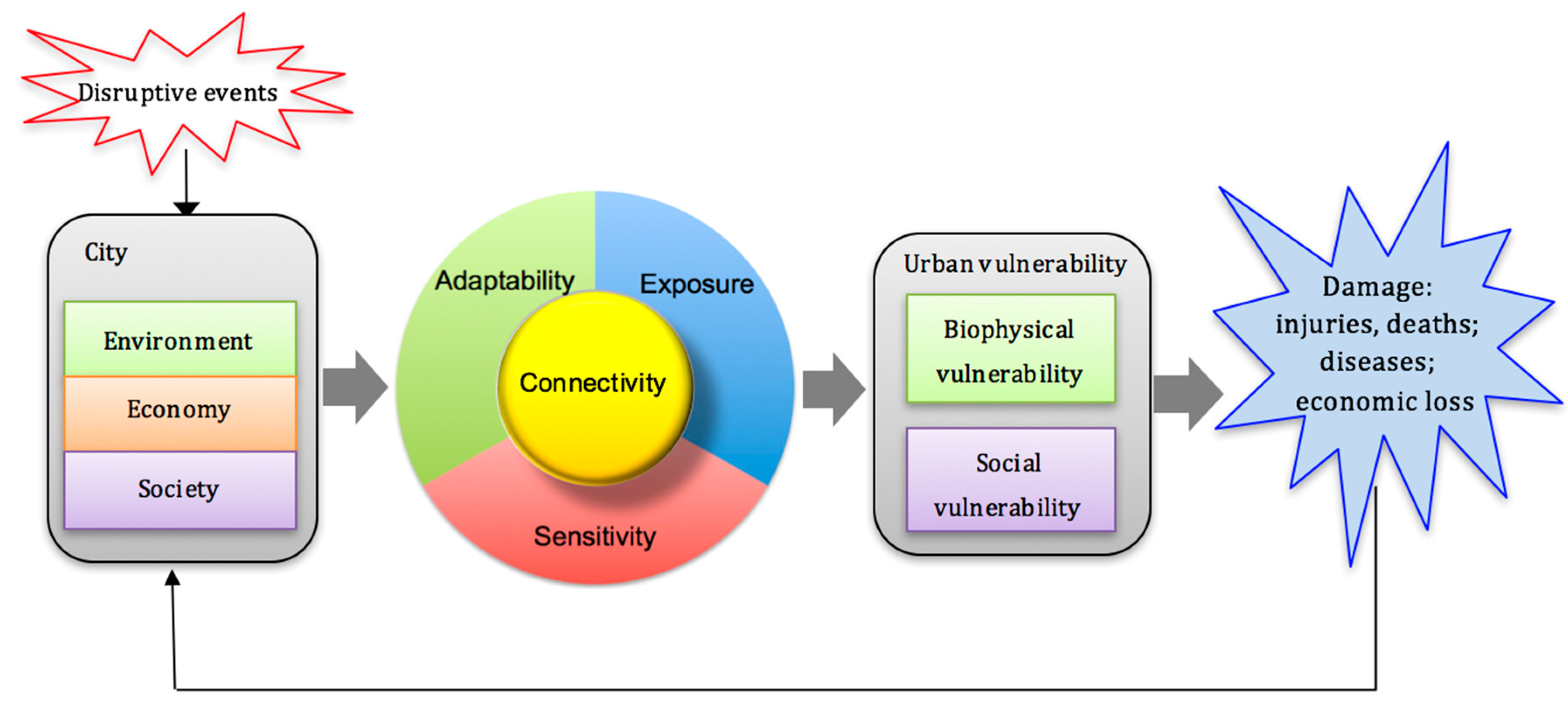
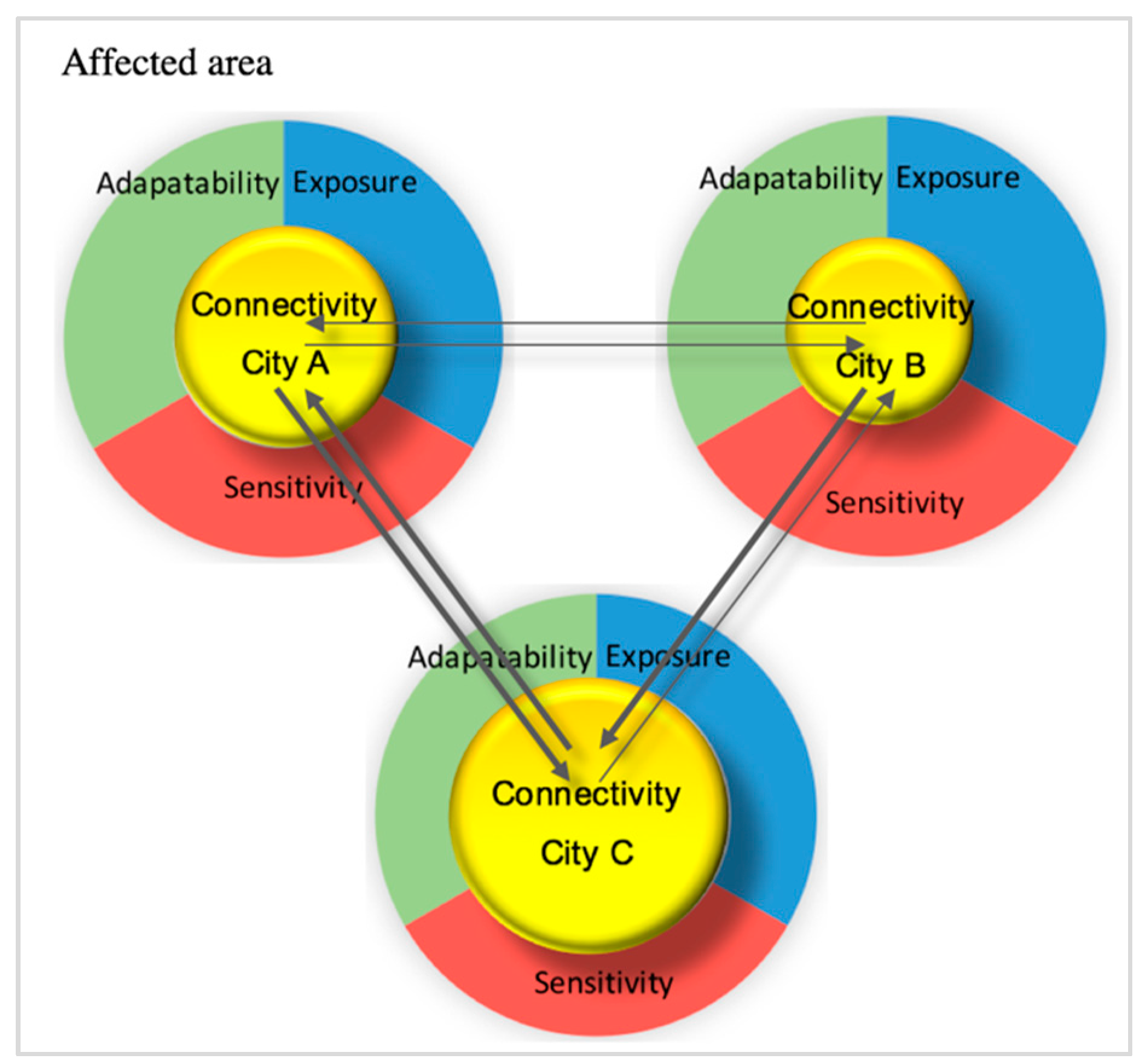
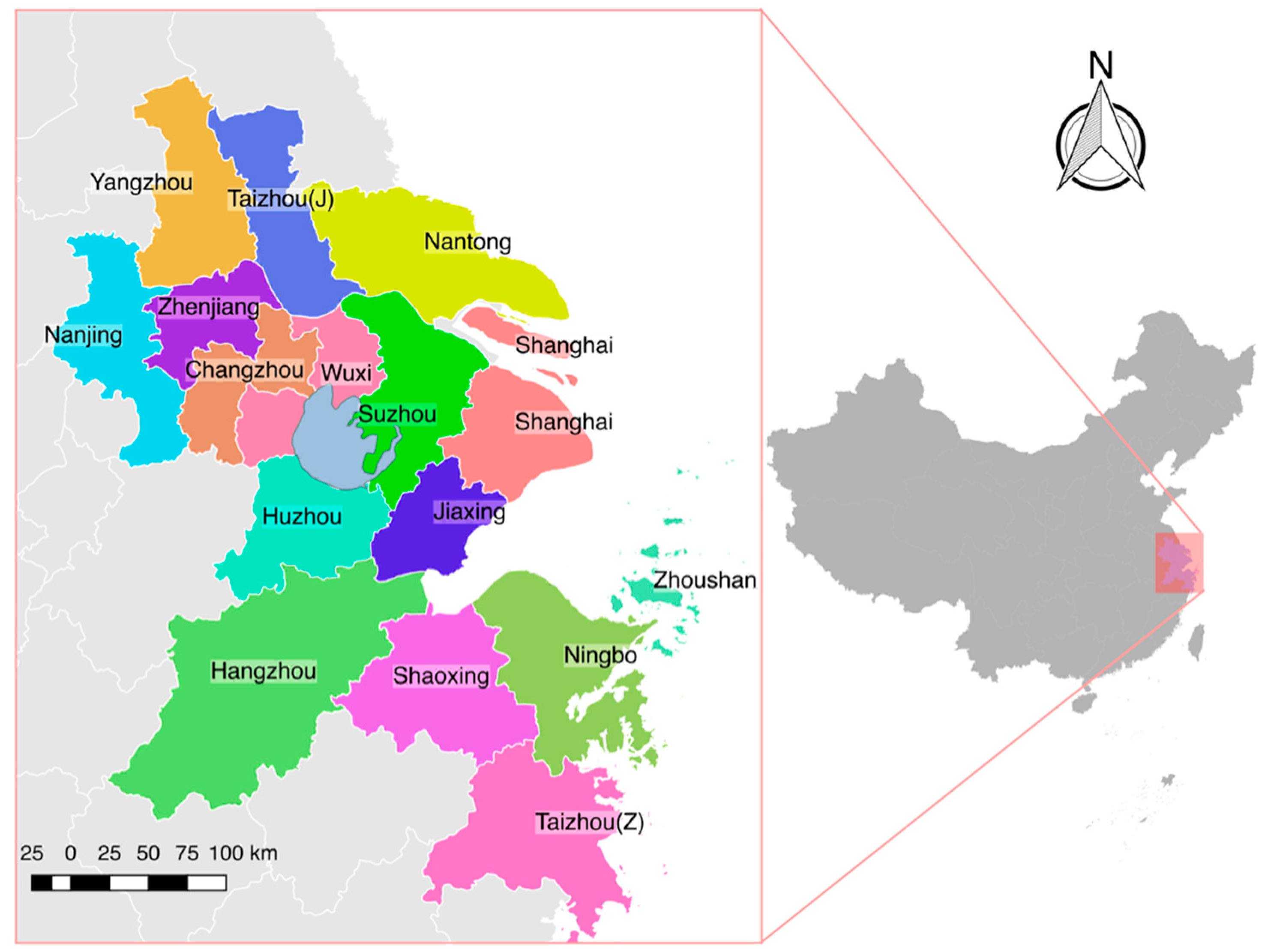
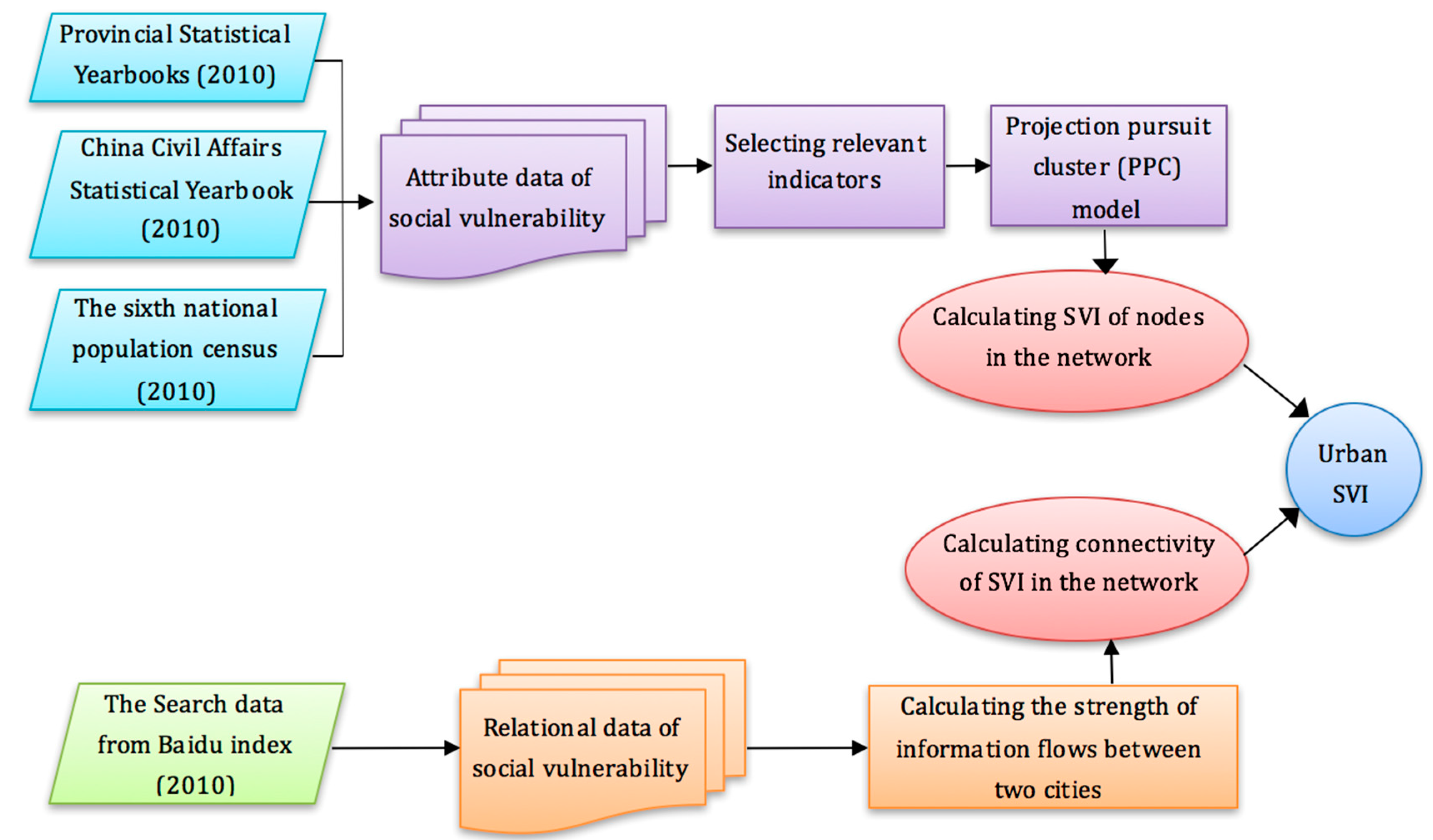

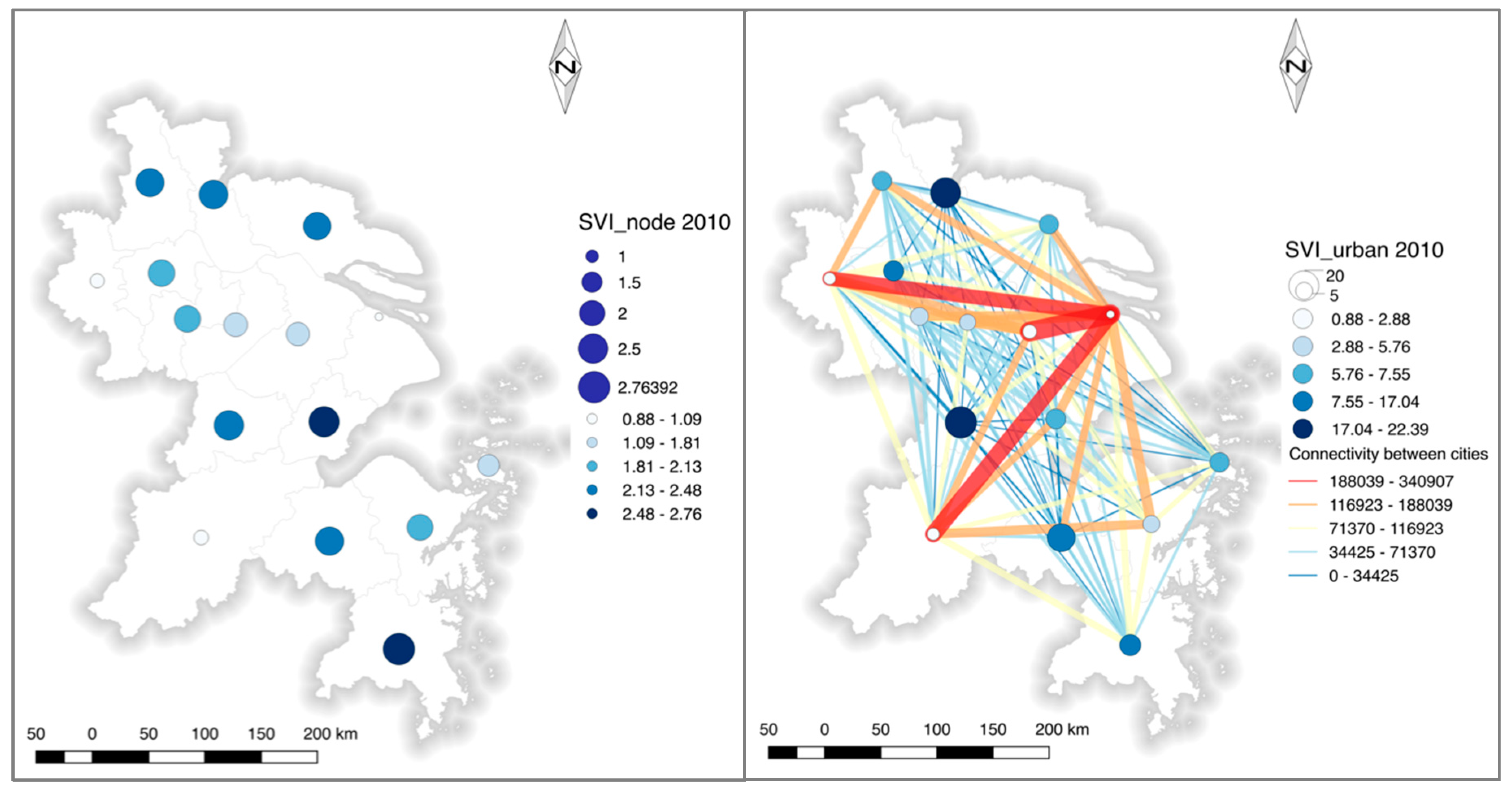
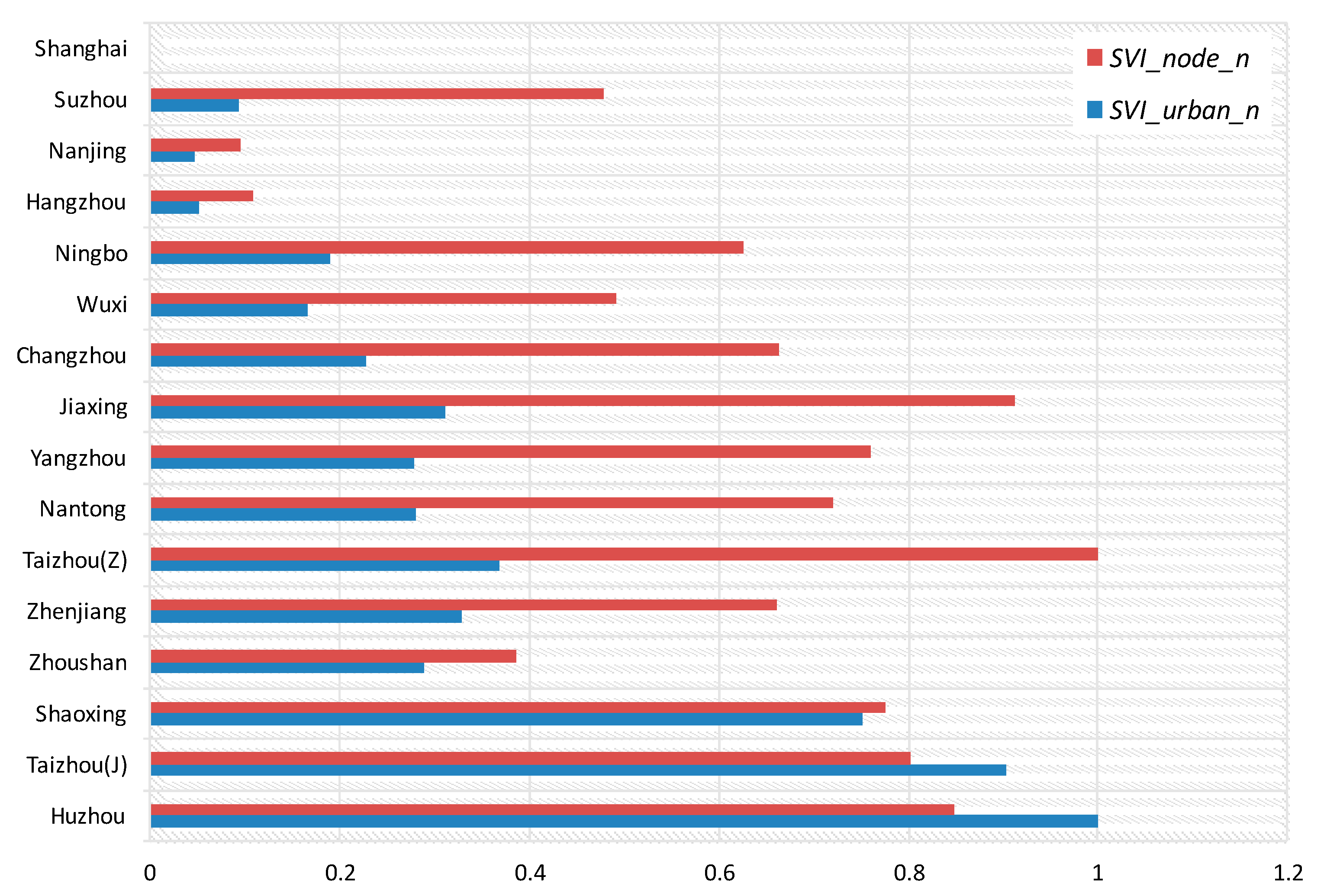
| City | Province | Urbanization (%) | Population (Million) | Land Area (sq. km2) | Population Density (People Per km2) | GDP (Billion Yuan) | GDP Per Capita (Yuan) |
|---|---|---|---|---|---|---|---|
| Shanghai | Shanghai | 89.30 | 23.47 | 6341 | 3632 | 1716.60 | 76,074 |
| Nanjing | Jiangsu | 77.94 | 8.01 | 6587 | 960 | 513.07 | 65,273 |
| Hangzhou | Zhejiang | 73.25 | 8.71 | 16,596 | 524 | 594.92 | 86,691 |
| Wuxi | Jiangsu | 70.31 | 6.38 | 4627 | 1008 | 579.33 | 92,167 |
| Suzhou | Jiangsu | 70.07 | 10.47 | 8488 | 751 | 922.89 | 93,043 |
| Ningbo | Zhejiang | 68.31 | 7.61 | 9816 | 775 | 516.30 | 90,175 |
| Zhoushan | Zhejiang | 63.59 | 1.12 | 1440 | 672 | 64.43 | 66,581 |
| Changzhou | Jiangsu | 63.17 | 4.59 | 4372 | 825 | 304.49 | 67,327 |
| Zhenjiang | Jiangsu | 61.97 | 3.12 | 3847 | 704 | 198.76 | 64,284 |
| Shaoxing | Zhejiang | 58.58 | 4.91 | 8279 | 530 | 279.52 | 63,770 |
| Yangzhou | Jiangsu | 56.75 | 4.46 | 6591 | 697 | 222.95 | 49,786 |
| Nantong | Jiangsu | 55.80 | 7.28 | 8001 | 954 | 346.57 | 48,083 |
| Taizhou | Jiangsu | 55.64 | 4.62 | 5787 | 872 | 204.87 | 44,118 |
| Taizhou | Zhejiang | 55.54 | 5.97 | 9411 | 620 | 242.65 | 41,777 |
| Jiaxing | Zhejiang | 53.33 | 4.51 | 3915 | 873 | 230.02 | 67,534 |
| Huzhou | Zhejiang | 52.89 | 2.89 | 5818 | 447 | 130.17 | 50,149 |
| The YRD region | 57.19 | 102.15 | 100,505 | 1016 | 6824.89 | 68,337 | |
| The country | 49.95 | 1340.91 | 9,600,000 | 140 | 40,151.28 | 30,015 | |
| City | Connectivity | Connectivity Structure | |||||
|---|---|---|---|---|---|---|---|
| Flow-In | Flow-In (%) | Flow-Out | Flow-Out (%) | Itself | Itself (%) | ||
| Shanghai | 2,456,274 | 1,012,732 | 28.6 | 1,443,542 | 40.8 | 1,085,578 | 30.6 |
| Suzhou | 1,552,866 | 764,621 | 34.9 | 788,245 | 36.0 | 638,744 | 29.1 |
| Nanjing | 1,482,085 | 817,798 | 41.5 | 664,287 | 33.7 | 487,696 | 24.8 |
| Hangzhou | 1,466,046 | 774,536 | 39.5 | 691,510 | 35.2 | 496,902 | 25.3 |
| Ningbo | 1,110,875 | 581,852 | 39.8 | 529,023 | 36.2 | 352,219 | 24.0 |
| Wuxi | 1,119,289 | 624,139 | 43.2 | 495,150 | 34.3 | 326,154 | 22.5 |
| Changzhou | 999,329 | 592,878 | 45.2 | 406,451 | 31.0 | 310,951 | 23.8 |
| Jiaxing | 915,068 | 488,300 | 40.0 | 426,768 | 35.0 | 304,749 | 25.0 |
| Yangzhou | 903,912 | 555,265 | 46.4 | 348,647 | 29.1 | 293,219 | 24.5 |
| Nantong | 891,827 | 518,189 | 45.1 | 373,638 | 32.5 | 256,739 | 22.4 |
| Taizhou (Z) | 834,969 | 452,718 | 40.7 | 382,251 | 34.4 | 277,772 | 24.9 |
| Zhenjiang | 782,454 | 433,599 | 45.8 | 348,855 | 36.8 | 164,911 | 17.4 |
| Zhoushan | 685,121 | 443,720 | 55.3 | 241,401 | 30.1 | 117,048 | 14.6 |
| Shaoxing | 487,174 | 65,708 | 13.5 | 421,466 | 86.5 | 0 | 0.0 |
| Taizhou (J) | 417,266 | 64,938 | 15.6 | 352,328 | 84.4 | 0 | 0.0 |
| Huzhou | 392,207 | 57,388 | 14.6 | 334,819 | 85.4 | 0 | 0.0 |
| No. | City | Province | Hierarchy | SVInode | SVIurban | Variation |
|---|---|---|---|---|---|---|
| 1 | Shanghai | Shanghai | 1 | 0.0000 | 0.0000 | 0.0% |
| 1 | Suzhou | Jiangsu | 2 | 0.4771 | 0.0927 | −80.6% |
| 2 | Hangzhou | Zhejiang | 2 | 0.1093 | 0.0503 | −54.0% |
| 3 | Nanjing | Jiangsu | 2 | 0.0943 | 0.0476 | −49.5% |
| Mean value: | 0.2269 | 0.0635 | −61.3% | |||
| 1 | Ningbo | Zhejiang | 3 | 0.6258 | 0.1908 | −69.5% |
| 2 | Wuxi | Jiangsu | 3 | 0.4918 | 0.1649 | −66.5% |
| 3 | Jiaxing | Zhejiang | 3 | 0.9128 | 0.3099 | −66.1% |
| 4 | Changzhou | Jiangsu | 3 | 0.6642 | 0.2269 | −65.8% |
| 5 | Yangzhou | Jiangsu | 3 | 0.7604 | 0.2771 | −63.6% |
| 6 | Taizhou (Z) | Zhejiang | 3 | 1.0000 | 0.3679 | −63.2% |
| 7 | Nantong | Jiangsu | 3 | 0.7214 | 0.2801 | −61.2% |
| 8 | Zhenjiang | Jiangsu | 3 | 0.6610 | 0.3286 | −50.3% |
| Mean value: | 0.7297 | 0.2683 | −63.3% | |||
| 1 | Zhoushan | Zhejiang | 4 | 0.3848 | 0.2889 | −24.9% |
| 2 | Shaoxing | Zhejiang | 4 | 0.7762 | 0.7509 | −3.3% |
| 3 | Taizhou (J) | Jiangsu | 4 | 0.8029 | 0.9034 | 12.5% |
| Mean value: | 0.6546 | 0.6477 | −5.2% | |||
| 1 | Huzhou | Zhejiang | 5 | 0.8488 | 1.0000 | 17.8% |
© 2017 by the authors. Licensee MDPI, Basel, Switzerland. This article is an open access article distributed under the terms and conditions of the Creative Commons Attribution (CC BY) license (http://creativecommons.org/licenses/by/4.0/).
Share and Cite
Ge, Y.; Dou, W.; Zhang, H. A New Framework for Understanding Urban Social Vulnerability from a Network Perspective. Sustainability 2017, 9, 1723. https://doi.org/10.3390/su9101723
Ge Y, Dou W, Zhang H. A New Framework for Understanding Urban Social Vulnerability from a Network Perspective. Sustainability. 2017; 9(10):1723. https://doi.org/10.3390/su9101723
Chicago/Turabian StyleGe, Yi, Wen Dou, and Haibo Zhang. 2017. "A New Framework for Understanding Urban Social Vulnerability from a Network Perspective" Sustainability 9, no. 10: 1723. https://doi.org/10.3390/su9101723




